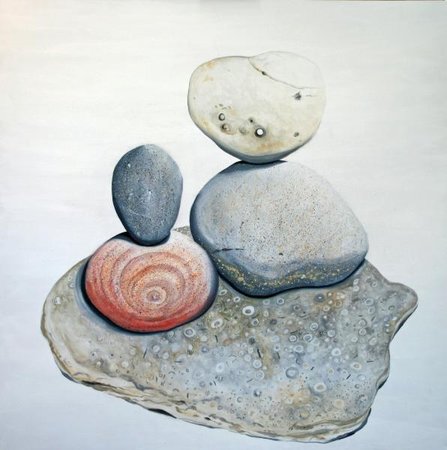by Carolyn Edlund
How art sales really work, and what you need to know to prepare to cultivate your own collectors.

Artist credit: “Stacked Creek Stones” by Judith HeartSong
You’ve probably seen them. Paintings and other works of art listed online for $5,000, $10,000, $20,000 or more. And next to them, a “Buy” button. You may have wondered, “Does anybody actually ever put those expensive things into a shopping cart and buy them online?”
Not very likely. I am very much in favor of artists listing their prices online. But I know that these items and their availability don’t really translate into “click and buy.”
Viewing works of art and their prices is usually just the beginning of the customer journey. This is the start of the sales cycle. It’s where potential buyers will be identified and qualified. And it’s where the artist enters into communication with the customer to move the process along.
Letting the public know your prices means they might self-select out of your pool of prospective buyers. Or, your prices are affordable for them, it will help move them to the next stage in the sales cycle.
Types of sales cycles
Some sales cycles are short. You exhibit at an art or craft fair, and a customer comes into your booth. They see something they like, say a handmade necklace. They love it, try it on, and buy it. Is your part over after you wrap up their purchase? Actually, no. You will obtain their contact information and stay in touch. Then, you can make other sales to them in the future as you go through another cycle with the same customer. And the second sale is usually easier to make.
Other sales cycles are long. Some are waaaaay long. If you are a bronze sculptor seeking to create large outdoor installations at universities or in public areas, you have a very different cycle. It will most likely start with research to find the small pool of prospects looking to commission this type of work. Presentations and negotiations can be protracted, and you must have patience. As in the patience of Job.
If that is your type of art business, you will understand how to go about finding and attracting prospective customers. You have learned what you need to do every step along the way to move the sales cycle forward to the close.
Cycles in different markets
Some industries have longer sales cycles because you need to become known, and seen, and remembered. Customers must be comfortable with the fact that you have established a business that isn’t going to disappear. They need confidence in order to develop a working relationship with you that endures. Artists who license their work often have a long cycle since manufacturers will be signing contracts with them that last for years, in an ongoing relationship. Likewise, wholesale buyers often need to see the artist and their work several times before even considering a purchase for their store or gallery. They want to know you will be sticking around.
Your different collections or lines may have different sales cycles. Reproductions or prints, lower-end or production work might sell more quickly and have a different customer base altogether than your higher-priced, original or one-of-a-kind work. And you may have to sell them in very different ways. This means that you need to understand the different sales cycles for your art. And, you must create systems to move prospective customers through those cycles.
Most potential sales fall through. Ultimately sales is a numbers game, and lots of people need to see your art before a purchase is made. Carefully select venues (whether in-person or online) that most attract the ideal customer for your work. This enables your art to be seen, and seen again. Then you can start to get nibbles that turn into opportunities that you can then turn into sales.
It’s up to you to clearly understand your own sales process and the timelines involved. Outline the steps you must go through when selling the different types of work that you make.
The importance of follow up
The best way to lose sales is to ignore your cycle and fail to step up and contact your customers at the right time and in the right way to seal the deal. This happens all the time. Artists sometimes don’t feel comfortable sending an email or making a call. They don’t follow up with people who could become collectors of their work. This leaves money on the table and drives away the very customers they would like to cultivate.
“Cultivate” is actually a perfect word for bringing customers through your sales cycle as an artist. Like a farmer planting a seed that must be nurtured and grown into maturity and harvested, your actions in promoting and putting your art into the marketplace plant the seeds of your own future sales. Don’t walk away from these opportunities once they appear. Create a solid and workable plan to move those prospects into a new category, called “your collectors.” Become sharply aware of the cues that your prospects give when they need communication from you, answers to questions, or reassurance to overcome fears and objections to the sale.
Follow up regularly. Focus on great customer service. Offer lots of information so that the customer has a comfort level with buying your work. Be accessible and responsive. And make sure you are absolutely clear about your goal of making the sale and the actions to be taken to make it a reality.


Great article and I notice the use of the word ‘conversation’. That’s precisely it, selling your art is a conversation, its about selling you as an artist and all the negotiation is about building a relationship and reputation.
Its not about selling widgets but selling yourself and building a customer base (whether they buy or not)
Joe
Great input, thanks so much, Carolyn! Best, Lisa